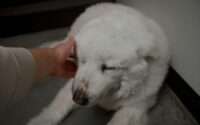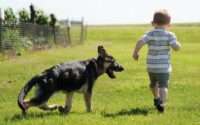How to Train a Husky: Unleash Your Dog’s Potential Today with Our Ultimate Guide!
Huskies, with their striking appearance and spirited personalities, are a breed unlike any other. Behind those piercing blue eyes lies a bundle of energy and intelligence, ready to explore the world and embark on adventures with their human companions. However, along with their boundless enthusiasm comes the need for proper training and guidance.
In this comprehensive guide, we’ll delve into the world of Husky training, providing you with the knowledge and techniques you need to unlock your Husky’s full potential. From understanding their unique temperament to mastering essential training principles, we’ll equip you with the tools to build a strong bond and a well-behaved Husky.
Understanding Huskies
Before diving into training techniques, it’s essential to understand the Husky breed and what sets them apart. Huskies, originally bred as sled dogs in cold climates, possess a combination of intelligence, independence, and an innate desire to roam. These traits make them both fascinating companions and formidable training subjects.
Huskies thrive on activity and mental stimulation, often displaying a mischievous streak if left to their own devices. Their strong prey drive and pack-oriented nature require careful management and channeling to ensure they behave appropriately in various situations. Understanding these breed characteristics is the first step in tailoring your training approach to suit your Husky’s needs.
In the following sections, we’ll explore fundamental training principles and specific techniques tailored to the unique qualities of Huskies, empowering you to navigate the training journey with confidence and success.
Basic Training Principles
Training a Husky begins with establishing a solid foundation built on positive reinforcement and clear communication. Here are some basic training principles to keep in mind:
- Positive Reinforcement: Huskies respond best to positive reinforcement techniques, such as praise, treats, and play. Rewarding desired behaviors encourages repetition and strengthens the bond between you and your Husky.
- Consistency: Consistency is key in Husky training. Set clear expectations and rules, and enforce them consistently. Huskies thrive on routine and structure, so maintaining consistency in your training approach will yield better results.
- Patience: Training a Husky can be challenging at times, especially given their independent nature. Patience is essential. Keep training sessions short and enjoyable, and be patient with your Husky as they learn new behaviors.
- Clear Communication: Huskies are intelligent dogs but can be stubborn at times. Use clear, concise commands and body language to communicate your expectations. Avoid yelling or punishment, as this can undermine trust and hinder progress.
Training Essentials for Huskies
Certain training exercises are essential for every Husky owner to master. These include:
- Crate Training: Crate training provides your Husky with a safe and comfortable space to call their own. Start crate training early and make the crate a positive and rewarding place for your Husky to be.
- Potty Training: Consistency is key in potty training. Take your Husky outside frequently, especially after meals and naps, and praise them lavishly when they eliminate outside. Accidents will happen, so be patient and persistent.
- Leash Training: Huskies are strong and independent dogs, so leash training is essential for safety and control. Teach your Husky to walk politely on a leash using positive reinforcement techniques and plenty of rewards for good behavior.
- Basic Obedience Commands: Teach your Husky basic obedience commands such as sit, stay, come, and down. These commands form the foundation of good manners and can be lifesaving in certain situations.
By mastering these basic training principles and essential exercises, you’ll lay the groundwork for a well-behaved and well-adjusted Husky.
Advanced Training Techniques
Once you’ve mastered the basics, it’s time to take your Husky’s training to the next level with advanced techniques designed to challenge their intellect and abilities:
- Recall Training: Teaching your Husky reliable recall commands is essential for off-leash freedom and safety. Start in a low-distraction environment and gradually increase the level of difficulty as your Husky becomes more reliable.
- Off-Leash Training: Huskies have a strong independent streak, making off-leash training particularly challenging. Use long lines and secure, enclosed areas to practice off-leash skills gradually, reinforcing good behavior with high-value rewards.
- Advanced Obedience Commands: Build on your Husky’s basic obedience skills by introducing more advanced commands such as “heel,” “leave it,” and “drop it.” These commands are useful in real-life situations and help reinforce your Husky’s training foundation.
Husky-Specific Training Challenges
Training a Husky comes with its unique set of challenges due to their independent nature and strong prey drive. Here are some common challenges Husky owners may encounter:
- Stubbornness: Huskies are known for their stubborn streak, which can make training frustrating at times. Patience and persistence are key. Break training exercises into small, manageable steps and use plenty of positive reinforcement to encourage cooperation.
- High Energy Levels: Huskies are energetic dogs that require plenty of physical and mental stimulation. Lack of exercise can lead to boredom and destructive behaviors. Incorporate daily walks, runs, and interactive play sessions into your Husky’s routine to keep them mentally and physically engaged.
- Prey Drive: Huskies have a strong prey drive, which can make recall and off-leash training challenging. Use high-value rewards and positive reinforcement techniques to redirect your Husky’s focus away from potential prey and back to you.
Through understanding and addressing these Husky-specific training challenges, you can set yourself and your Husky up for success in your training journey.
Mental Stimulation and Enrichment Activities
Keeping your Husky mentally stimulated is just as important as physical exercise. Here are some engaging enrichment activities to keep your Husky’s mind sharp and boredom at bay:
- Puzzle Toys: Invest in interactive puzzle toys that challenge your Husky’s problem-solving skills. Fill toys with treats or kibble to encourage your Husky to work for their food, keeping them mentally engaged and entertained.
- Scent Games: Huskies have an excellent sense of smell, making scent games an ideal way to stimulate their minds. Hide treats or toys around the house or in the yard and encourage your Husky to use their nose to find them.
- Training Games: Turn training sessions into fun games that challenge your Husky’s mind and reinforce obedience commands. Incorporate hide and seek, fetch, and other interactive games into your training routine to keep your Husky engaged and motivated.
Training for Husky Sports and Activities
Huskies excel in a variety of sports and activities that capitalize on their athleticism and endurance. Here are some popular Husky sports and activities to consider:
- Agility: Agility courses are a great way to channel your Husky’s energy and intelligence into a structured activity. Teach your Husky to navigate obstacles such as tunnels, jumps, and weave poles, building confidence and coordination in the process.
- Obedience Trials: Obedience trials test your Husky’s ability to perform a series of obedience exercises with precision and reliability. Train your Husky to heel, stay, come, and perform other commands accurately in a variety of settings to prepare for competition.
- Sledding: Sledding is a traditional Husky activity that taps into their natural instincts and love of running. Introduce your Husky to sledding gradually, starting with short runs and gradually increasing distance and difficulty as they gain confidence and experience.
Integrating mental stimulation and enrichment exercises into your Husky’s daily regimen, alongside exploring sports and activities designed for their breed, ensures they remain both physically and mentally satisfied while deepening the bond you share.
Training Throughout Husky’s Life Stages
Training a Husky is an ongoing journey that evolves as your dog grows and matures. Here are some training considerations for different life stages:
- Husky Puppies: Start training early with positive reinforcement techniques to establish good habits and prevent behavior problems. Focus on socialization and basic obedience commands, keeping training sessions short and fun to accommodate a puppy’s short attention span.
- Adolescent Huskies: Adolescence can be a challenging time for Huskies as they test boundaries and assert their independence. Maintain consistency in your training approach and continue to reinforce obedience commands while providing plenty of physical and mental stimulation to keep them engaged.
- Adult Huskies: Adult Huskies benefit from continued training and reinforcement of obedience commands to maintain good manners and behavior. Tailor training sessions to your Husky’s individual needs and interests, and adjust your approach as they mature and their training goals evolve.
Troubleshooting and Problem-Solving
Even the most well-behaved Huskies can encounter training challenges from time to time. Here are some common issues Husky owners may face and how to address them:
- Pulling on the Leash: Huskies are known for their strong pulling instinct, which can make leash walking challenging. Use positive reinforcement techniques to teach your Husky to walk politely on a leash, and consider using a front-clip harness or head collar for added control.
- Excessive Barking: Huskies are vocal dogs that may bark or howl excessively, especially when bored or under-stimulated. Address excessive barking by providing plenty of physical and mental exercise, teaching the “quiet” command, and using positive reinforcement to reward calm behavior.
- Digging: Digging is a natural behavior for Huskies, but it can become problematic if left unchecked. Provide your Husky with a designated digging area, such as a sandbox or digging pit, and redirect their digging behavior to this area using positive reinforcement.
- Escaping: Huskies are notorious escape artists known for their Houdini-like ability to find a way out of fenced yards. Prevent escaping by ensuring your yard is securely fenced and escape-proof, and supervise your Husky when they’re outside to prevent wandering.
With patience, consistency, and positive reinforcement, you can tackle typical training hurdles, fostering a robust connection with your Husky as you progress.
Celebrating Successes and Building a Strong Bond
Celebrating successes in training is an important part of the journey with your Husky. Here are some ways to acknowledge milestones and strengthen your bond:
- Positive Reinforcement: Continue to use positive reinforcement to reward your Husky’s good behavior and achievements. Praise, treats, and affection are powerful motivators that reinforce the bond between you and your furry companion.
- Quality Time Together: Spend quality time with your Husky engaging in activities you both enjoy, such as walks, hikes, and playtime. Building shared experiences strengthens your bond and reinforces your role as your Husky’s trusted companion and leader.
- Training Games and Challenges: Keep training fun and engaging by incorporating games and challenges into your routine. Teach your Husky new tricks, work on advanced obedience commands, or participate in canine sports together to keep training sessions exciting and rewarding.
Conclusion
Training a Husky is a rewarding journey that requires patience, consistency, and dedication. By understanding your Husky’s unique temperament and needs, establishing clear communication and boundaries, and using positive reinforcement techniques, you can build a strong foundation of trust and obedience that will last a lifetime.
Remember, training is not just about teaching commands; it’s about strengthening the bond between you and your Husky and enriching your relationship in meaningful ways. Embrace the journey, celebrate successes, and cherish the special moments you share with your furry friend.
We hope this comprehensive guide has provided you with valuable insights and practical tips for training your Husky effectively. Whether you’re a first-time owner or a seasoned Husky enthusiast, we wish you success and happiness in your training adventures. Together, you and your Husky can achieve great things and create memories that will last a lifetime.
Frequently Asked Questions
How long does it take to train a Husky?
Training a Husky varies depending on factors like age, temperament, and consistency in training. With positive reinforcement and patience, basic obedience commands can be mastered in a few weeks, while more advanced training may take several months of consistent practice.
What is the best age to start training a Husky?
It’s best to start training a Husky as early as possible, ideally around 8 to 12 weeks of age. Early socialization and training help prevent behavior problems and establish good habits from the start.
Are Huskies difficult to train?
Huskies are intelligent and independent dogs that can be challenging to train, especially for first-time owners. However, with patience, consistency, and positive reinforcement techniques, Huskies can learn and excel in training.
How do I stop my Husky from pulling on the leash?
Teaching loose leash walking requires patience and consistency. Start by rewarding your Husky for walking by your side and using positive reinforcement techniques to discourage pulling. Consider using a front-clip harness or head collar for added control.
Can I train my Husky to be off-leash?
Training a Husky to be off-leash requires careful supervision, consistent training, and a reliable recall command. Start in a controlled environment and gradually increase distractions as your Husky becomes more reliable.
How do I potty train my Husky?
Potty training requires patience and consistency. Take your Husky outside frequently, especially after meals and naps, and reward them lavishly when they eliminate outside. Supervise your Husky indoors and use positive reinforcement to prevent accidents.
Are there specific training techniques for Husky puppies?
Training techniques for Husky puppies focus on positive reinforcement, socialization, and establishing good habits early on. Keep training sessions short and fun to accommodate a puppy’s short attention span.
What should I do if my Husky displays destructive behaviors?
Destructive behaviors in Huskies are often a sign of boredom or lack of exercise. Provide plenty of physical and mental stimulation, such as walks, runs, and interactive toys, to prevent boredom and channel your Husky’s energy in positive ways.
How can I build a strong bond with my Husky through training?
Building a strong bond with your Husky through training requires patience, consistency, and positive reinforcement. Spend quality time together, engage in activities you both enjoy, and celebrate successes to strengthen your bond.
What if I’m having trouble training my Husky?
If you’re having trouble training your Husky, seek guidance from a professional dog trainer or behaviorist. They can provide personalized advice and techniques to address specific training challenges and help you achieve success with your Husky.




